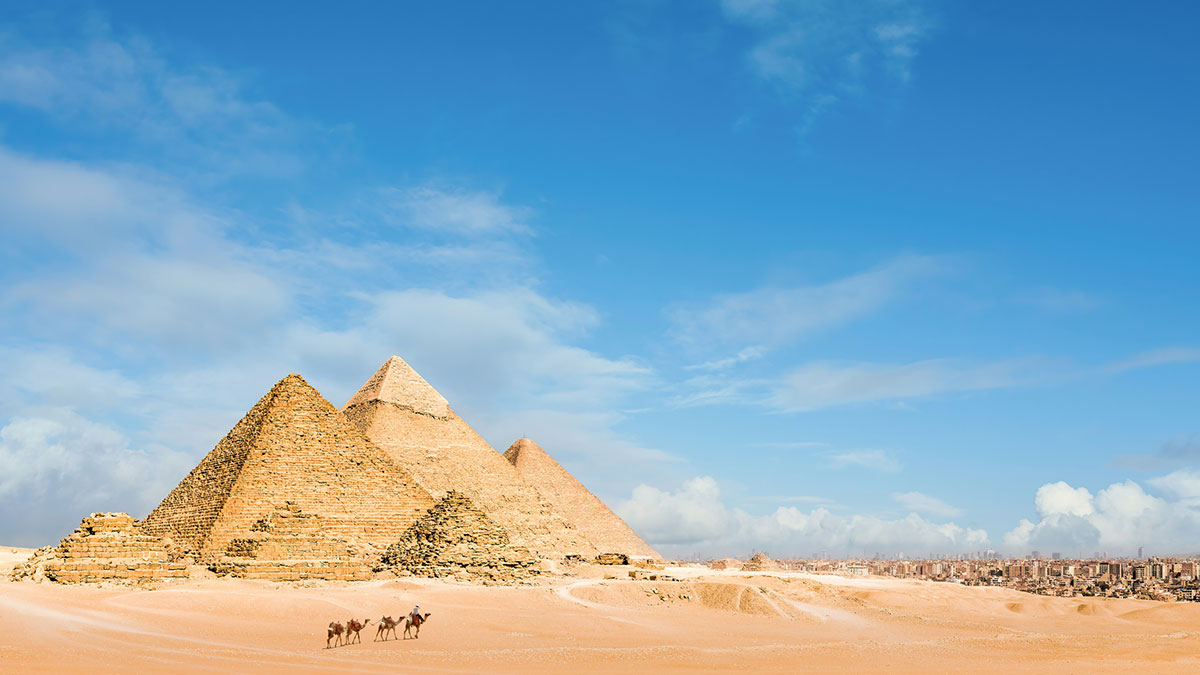Why Egypt is the ultimate historic destination

Pic via Getty Images.
What started with a flirtation with King Tutankhamun has blossomed into a lifelong affair.
Words by George Epaminondas at escape.com.au
Walk and talk like an Egyptian… An early poster boy for hoarding, King Tut was buried with over 5000 belongings – amulets, daggers, sandals, and ivory-lined board games among them. In the basement of the Grand Egyptian Museum in Giza, I scribbled notes as preservationists avidly restored some of these elaborate objects.
“Please, no pen!” a guide instructed, fearful that an errant drop of ink might sully the priceless antiquities sprawled around us. I smiled sheepishly but nothing could detract from the wonderment of the scene.
What defines a life-changing trip? For me, it’s one that alters your outlook, seeps into your dreams, and lives rent-free in your hippocampus, the part of the brain where memories lodge.
Based on these metrics, venturing to Egypt was the journey of a lifetime. Somewhere between the falcon head of Horus and the lion paws of the Sphinx, I fell hard for its sacred animal cults, ceremonial rites and inscrutable designs. Five years later, I’m still gripped.
Some men regularly obsess over Ancient Rome, as a social media trend from last year theorised, but it’s the land of the pharaohs that has caught my eye – the stylised eye of Ra, that is.
On my stay, I was fortunate to join a magic carpet ride hosted by Abercrombie & Kent. The luxury travel pioneer has operated in Egypt for over four decades, and its expert guides know Nefertiti from Nefertari. Accompanying us was an Egyptologist who deciphered hieroglyphics by day and bantered over dinner at night.
We marvelled at the pyramids of Giza, hop-scotched around the temples of Aswan in the south, and inspected the catacombs of Alexandria in the north – all with the zeal of Indiana Jones.

Eventually, I came to recognise various cartouches, the oval-shaped emblems used by pharaohs. Ramses II built more monuments than any other ruler, but nothing prepared me for the jaw-dropping sight of Abu Simbel, the colossal rock-cut temples on the bank of Lake Nasser. A marvel of Egyptian engineering, it still has the power to impress.
Exhibitions can help conjure the majesty of Egypt’s cultural riches, but they are no replacement for beholding the forest of sandstone columns at Karnak.
Sailing the Nile on a wooden dahabiya was another high point. Flanked by dusty villages and lush plants, I felt the echoes of the past. In the Valley of the Kings, I was delighted to see that many of the subterranean tombs still retain their vibrant wall paintings.
Seti 1’s chamber was animated with images from the Book of the Dead in vivid shades of blue, red and gold.
READ MORE:
The $10 tip you need to know in Egypt
I found the Byron Bay of Egypt, hear me out
Like the Nile, Egypt’s tourism scene has ebbed and flowed over the years. Lately, it’s been rocked by the ongoing conflict in the Gaza Strip, yet industry insiders tell me that reservations are picking up.
The nation’s charms are not limited to age-old shrines. Its cities are equally intriguing, with legendary hotels, buzzy restaurants and urbane locales like Zamalek in Cairo to dip into. When Howard Carter sighted Tut’s treasures, he described them as “wonderful things”. A visitor might feel the same way about Egypt itself.
Escape.com.au articles may contain links from their affiliate and advertising partners. When you click on them, or share this content, they may earn a commission. Learn more.
Related Topics
UNLOCK INSIGHTS
Discover the untold stories of emerging ASX stocks.
Daily news and expert analysis, it's free to subscribe.
By proceeding, you confirm you understand that we handle personal information in accordance with our Privacy Policy.








